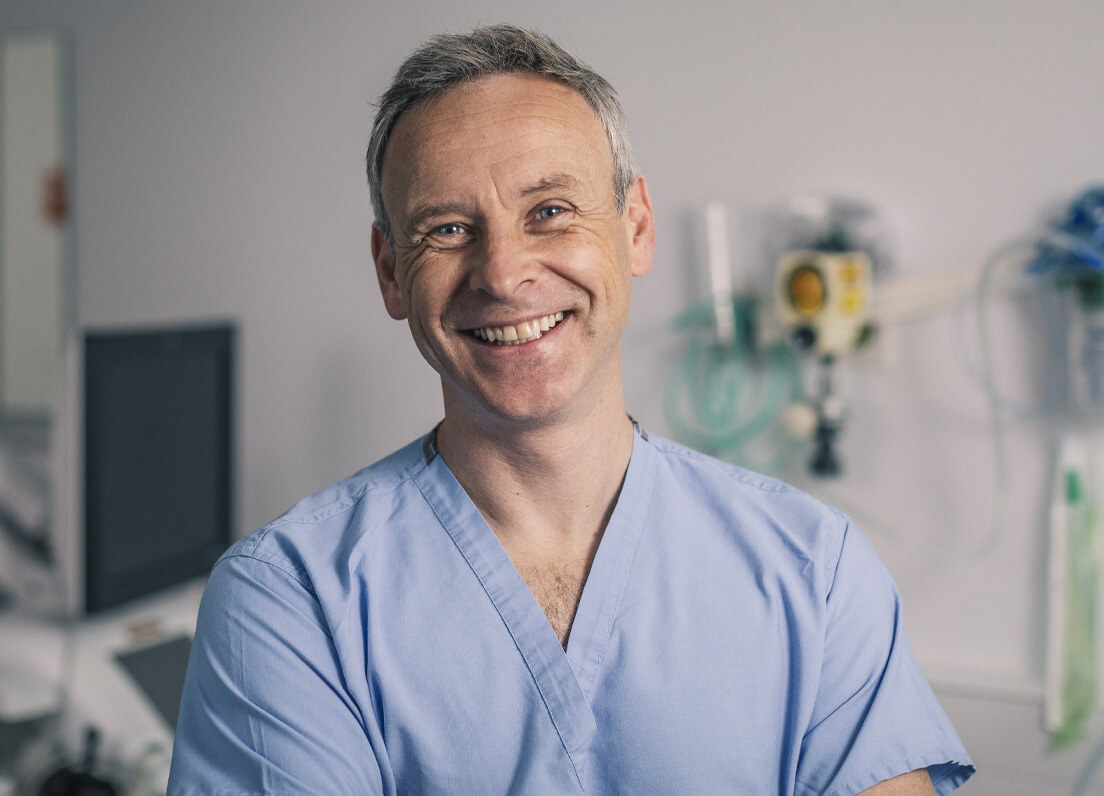Anyone considering surgery should approach the decision with a healthy amount of respect and caution especially when the surgery is elective (or planned) and is non essential surgery (as aesthetic or cosmetic surgery generally is). All surgical procedures have limitations in terms achievable outcome and it is important that your expectations match what is possible through surgery. The choice to go ahead with surgery is always (or should always be) taken after due consideration of the risk benefit balance for the procedure. Although the majority of patients do not experience problems it is important that you fully understand all the potential risks and complications of facelift surgery. It is important that you take the time to read over them again prior to your next consultation.
Bleeding
It is possible, though unusual, to experience a bleeding episode during or after surgery. Drains are often used to reduce the risk of haematoma formation (a collection of blood within the surgical site beneath the skin) post operatively. Significant post operative bleeding will require a return to theatres to remove the collection of blood and seal (coagulate) any bleeding points. Avoid the use of Asprin for 2 weeks prior to surgery as this increases the propensity to bleed, as can certain other medications (particularly non steroidal anti inflammatory medications, if in doubt please ask Mr. MacQuillan). Significant bleeding is unusual with face and neck lift surgery but if this occurs a blood transfusion may be required. High blood pressure is a risk factor for having a post operative bleed, as is taking certain dietary supplements, in addition to the medications described above. The facial skin is at risk of pigmentation, poor healing or necrosis in the event of a significant haematoma and this can result in adverse scarring.
Blood Transfusion
If blood transfusions are needed to treat blood loss, there is a risk of blood-related infections such as hepatitis and HIV (AIDS). Heparin medications that are used to prevent blood clots in veins can produce bleeding and decreased blood platelets.
Infection
Whenever the skin is cut there is always the risk of infection. With face and neck lift surgery the risk of infection is low, but if it occurs it may require further treatment ranging from specialist dressings, to antibiotics or hospitalization and can in certain circumstances require further surgery.
Changes in sensation
Patches of numbness or decreased sensation in the lateral portion of the cheek are common following face and neck lift surgery however these usually resolve with time. It is possible that these changes can be permanent. Very infrequently pain or uncomfortable sensations may be caused nerve entrapment within scar tissue (neuropathic pain).
Contour irregularities of the skin
Following face and neck lift surgery it is possible to get loss of smoothness of the surface of the skin (depressions or irregularities of the contours of the skin). It is also possible to get corrugation or pleating of the scar, tethering of the scar to underlying tissues and ‘dog ear’ formation at the ends of the scar. Such problems usually respond to massage and maturation of the scar with time, though very infrequently may require additional surgery to correct them.
Scarring
It is normal for scars to heal well following face and neck lift surgery however adverse scarring is always a possible outcome following any form of surgery. Scars can appear thick, red and raised all or part of the way along the incision line (a hypertrophic scar) or more rarely can involve tissues beyond the incision itself (and can resemble a badly healed burn), this is known as a keloid scar. Additionally scars can tether to underlying structures or become abnormally pigmented. It is possible that additional treatments may be required for adverse scarring.
Skin discolouration
Although bruising (together with swelling) is an inevitable consequence of face and neck lift surgery it is possible to get pigmentation changes in the skin nearby to the site of surgery. In Caucasian skin this often takes the form of increased pigmentation or darkening of the skin, in darker skin colours pigmentation may decrease around the scar site and lighten. With extensive bruising it is possible to get permanent increased pigmentation within the bruised areas (though this is unusual).
Fat necrosis
Fat cells in the subcutaneous tissue (under the skin) have a relatively poor blood supply and are quite susceptible to traumatic damage. With the effects of surgery it is possible for some of the fatty tissue to die and form scar tissue (which can be felt a lumpiness beneath the skin). If there are large areas of fatty tissue that suffer from necrosis this may require removal, or can result in prolonged discharge from the incision. If an area of fat necrosis became infected this would cause and abscess, which would require surgical drainage. It is possible that skin contour abnormalities can be caused by fat necrosis.
Seroma Formation
A seroma can be best thought of a collection of fluid beneath the skin at a surgical site. The composition of a seroma is much the same as that of blood but without the actual blood cells (it contains similar proteins and salts to blood) and is usually the result of lymphatic fluid accumulation (this is the 10% of the fluid that escapes from capillaries within tissues but does not return back to the veins via the small blood vessels but rather by the lymphatic drainage vessels) or by direct production from inflamed tissue (think of the tissues ‘sweating out’ the fluid). If this occurs there is the possibility it will need to be drained (often by simple aspiration with a needle or syringe, though in rarely can require a further operation to remove completely).
Asymmetry
No one has a symmetrical face and there will be differences between the sides both in the soft tissues and bony skeleton. Although the same procedure is performed on both sides of the face in face and neck lift surgery it will not correct and pre existing asymmetry and because of this there may be variation in the results obtained between one side and the other.
Delayed Healing
Wounds can break down following surgery (wound dehiscence) or after suture removal or may be slow to heal. If this occurs dressings may be required for a prolonged period of time (weeks to months) prior to wound healing and in occasional cases a further operation may be needed. Scar revision may be necessary in cases of delayed wound healing.
Skin Necrosis
If the blood supply to the skin is insufficient following surgery (which can be for a variety of reasons) the skin, particularly at the incision site, can necrose (die). If this happens the skin will form an eschar (scab) which may need to be removed surgically. Dressings are likely to be required for a period of time and further surgery may be needed.
Damage to Deeper Structures
The deeper tissues of the face are at risk of damage during a face and neck lift. The blood vessels, muscle and nerves are the areas of particular concern and the risk varies depending on the type of procedure being performed. The injury may be temporary or permanent.
Nerve Injury
Both the motor and sensory nerves that supply the face and neck can be damaged in face and neck lift surgery. This can result in altered sensation, loss of sensation (numbness) or (rarely) pain if a sensory nerve is injured. Impairment or loss of movement to part or all of one or both sides of the face can occur if a motor nerve (the facial nerve) is injured. Areas that can be affected if one or more of the branches of the facial nerve are injured resulting in partial or complete loss of movement include the forehead and brow, the eye, the cheek, upper and lower lips, the muscles of the neck. If there is loss of sensation or movement this is usually temporary and recovers by itself, however with more serious injury to the nerve the loss can be permanent and require further surgery.
Pain
You will have pain following surgery. The intensity and duration of the pain varies from individual to individual following face and neck lift surgery. Very infrequently chronic pain due to nerve damage or nerve entrapment in scar tissue may arise following face and neck lift surgery (neuropathic pain).
Skin Sag
With any procedure that stretches the skin to achieve a result the skin will respond elastically and stretch. As part of this response in addition to stretching the skin will also expand so that it is not under tension. This results in a varying degree of recurrence in ‘sagging’ of the skin which varies from individual to individual. The repositioning of the deeper soft tissues that changes the shape of the face relies initially on sutures to hold the change in position, however long term maintenance of this change relies on scar formation, the strength of which varies from individual to individual. Thus, the extent of soft tissue correction and durability of improvement produced by face and neck lift surgery is not guaranteed either in extent of correction or duration of correction.
Sutures
Most operations involve the routine use of deeply placed sutures (stiches) within and beneath the skin. Such sutures are usually designed to be dissolving however in some individuals they make take longer to dissolve than intended or may provoke a reaction from the body. In such instances they may form small pockets of inflammation (stitch granulomas or abscesses) which resemble an infection but are in fact due to the underlying stitch. Similarly the stitch may poke through the skin and become uncomfortable. In such cases the stitches will require removal.
Allergic Reactions
In rare cases, local allergies to tape, suture material and glues, blood products, topical preparations or injected agents have been reported. Serious systemic reactions including shock (anaphylaxis) may occur to drugs used during surgery and prescription medications. Allergic reactions may require additional treatment.
Hair Loss
Hair loss may occur in areas of the face where the skin has been elevated (this is relevant to male patients with regards to the beard area) or along the incision line. The occurrence of hair loss is not predictable and may or may not be permanent.
Deep Vein Thrombosis, Cardiac and Pulmonary Complications
Any procedure requiring general anaesthesia and immobilization for a period of time increases the risk of the formation of blood clots in the legs. Such clots can dislodge and move to the lungs, causing shortness of breath and strain on the heart. Such clots can potentially be fatal. Air travel, inactivity and other factors (medications such as the oral contraceptive pill or increased tendency to form clots) can increase the risk of clot formation. It is important you tell Mr. MacQuillan of any previous history of swollen legs or blood clots prior to surgery. If you experience shortness of breath, chest pains or feel palpitations (abnormal heart beats) following your surgery it is important you seek medical advice immediately.
Unsatisfactory Result
Although good results are expected, there is no guarantee or warranty expressed or implied, on the results that may be obtained. You may be disappointed with the results of face and neck lift surgery. This would include risks such as asymmetry, unsatisfactory or highly visible surgical scars, unacceptable visible deformities, bunching and rippling in the skin near the suture lines, poor healing, wound disruption and loss of sensation or movement. It may not be possible to correct the effects of surgical scars. Additional surgery may be required to improve results.
Long Term Outcomes:
The appearance of your face and neck will change with future alterations in body weight, aging, sun exposure and hormonal changes (such as medication and the menopause) together with other circumstances not related to your surgery. Future surgery or treatments may be required to maintain the results of your face and neck lift surgery.
Recommendations around the time of surgery:
- Clothing to wear to hospital – we recommend you wear a button or zip top for ease and comfort (such as a tracksuit top). This will mean you do not have to worry about pulling clothes over your head.
- Hair colouring – have your hair coloured the week prior to surgery, as you will not be able to colour your hair again for 6-weeks after surgery.
- Keeping your hair clean – use tea tree shampoo for daily gentle hair washing and dry your hair with a hair dryer on a cool setting.
- Sleeping – we suggest sleeping with extra pillows (or alternatively a wedge triangular pillow). This will help reduce the post-operative swelling.
- Drains – you will have a small surgical drain on each side after surgery. These will be removed the day after your operation.
- Do not bend forwards for the first couple of weeks to minimise problems with swelling – if you need to pick something up from the floor, please keep your head elevated and squat down. Similarly, when putting on shoes, please sit down and bring your feet up, rather than bending down.
- You will have a check up with the nurse one week after surgery at which time most of the stitches will be removed. The remaining stitches will be removed at two-weeks.
- Take things easy & slowly after surgery. Gentle pottering about, no heavy lifting or jumping up and down for first 2-3 weeks.
- After 6 weeks you can get back to normal exercise.
- Driving – you should be able to drive 1-2 weeks after surgery.
- Massage – this should be started at 2-3 weeks, and will be discussed with you.
- Scar care – moisturising your scars regularly is important. In addition, using silicone gel on the scars can help them to settle down more quickly.
- Make up and SPF factor of over 30 can be worn after surgery provided scars are healed.



